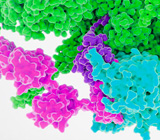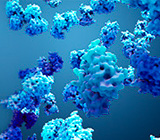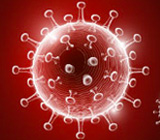-
REAGENT SERVICES
Hot!
-
Most Popular Services
-
Molecular Biology
-
Recombinant Antibody/Protein
-
Reagent Antibody
-
CRISPR Gene Editing
-
DNA Mutant Library
-
IVT RNA and LNP Formulations
-
Oligo Synthesis
-
Peptides
-
Cell Engineering
-
- CRISPR/Cas9 sgRNA
- CRISPR/Cas12a crRNA
- Prime Editing Guide RNA
- Base Editing Guide RNA
- HDR Templates
- gRNA + HDR Template Design Tools
- cGMP Guide RNA
- cGMP HDR Templates
- CRISPR/Cas Proteins
- CAR-T Knock-in Optimization Kit
- CRISPR Plasmids
- CRISPR gRNA Plasmid Libraries
- CRISPR Cell Lines
- Microbial Genome Editing
-
-
PRODUCTS
-
Most Popular Reagents
-
 Instruments
Instruments
-
Antibodies
-
ELISA Kits
-
Protein Electrophoresis and Blotting
-
Protein and Antibody Purification
-
Recombinant Proteins
-
Molecular Biology
-
Stable Cell Lines
-
Cell Isolation and Activation
-
 IVD Raw Materials
IVD Raw Materials
-
 Therapy Applications
Therapy Applications
-
Resources
-
- Pharmacokinetics and Immunogenecity ELISA Kits
- Viral Titration QC ELISA Kits
- -- Lentivirus Titer p24 ELISA KitHot!
- -- MuLV Titer p30 ELISA KitNew!
- -- AAV2 and AAVX Titer Capsid ELISA Kits
- Impurity Test ELISA Kits
- -- BSA ELISA Kit, 2G
- -- Cas9 ELISA KitNew!
- -- Protein A ELISA KitNew!
- -- His tagged protein detection & purification
- -- dsRNA ELISA Kit
- -- Endonuclease ELISA Kit
- COVID-19 Detection cPass™ Technology Kits
-
- Automated Maxi-Plasmid PurificationHot!
- Automated Mini-Plasmid PurificationNew!
- PCR Reagents
- S.marcescens Nuclease Benz-Neburase™
- DNA Assembly GenBuilder™
- Cas9 / Cas12a / Cas13a Nucleases
- Base and Prime Editing Nucleases
- GMP Cas9 Nucleases
- CRISPR sgRNA Synthesis
- HDR Knock-in Template
- CRISPR Gene Editing Kits and Antibodies
-
![AmMag™ Quatro Automated Plasmid Purification]() AmMag™ Quatro automated plasmid purification
AmMag™ Quatro automated plasmid purification
-
![Anti-Camelid VHH]() MonoRab™ Anti-VHH Antibodies
MonoRab™ Anti-VHH Antibodies
-
![ELISA Kits]() ELISA Kits
ELISA Kits
-
![Precast Gels]() SurePAGE™ Precast Gels
SurePAGE™ Precast Gels
-
![Quatro ProAb Automated Protein and Antibody Purification System]() AmMag™ Quatro ProAb Automated Protein and Antibody Purification System
AmMag™ Quatro ProAb Automated Protein and Antibody Purification System
-
![Target Proteins]() Target Proteins
Target Proteins
-
![AmMag™ Quatro Automated Plasmid Purification]() AmMag™ Quatro automated plasmid purification
AmMag™ Quatro automated plasmid purification
-
![Stable Cell Lines]() Stable Cell Lines
Stable Cell Lines
-
![Cell Isolation and Activation]() Cell Isolation and Activation
Cell Isolation and Activation
-
 IVD Raw Materials
IVD Raw Materials
-
![Quick
Order]() Quick Order
Quick Order
-
![Quick
Order]() Quick Order
Quick Order
- APPLICATIONS
- RESOURCES
- ABOUT US
- SIGN IN My Account SIGN OUT
- REGISTER

![Amino Acid Code Amino Acid Code]()
Biology Terms Dictionary
This Biology terms dictionary provides query services for biology and biochemistry terms. Please enter the biology or biochemistry terms you want to search.
List by Alphabet: A B C D E F G H I J K L M N O P Q R S T U V W X Y Z
VHH-Fc
Introduction
"VHH-Fc is a fusion antibody construct that combines the antigen-binding properties of VHH (variable heavy chain of heavy-chain-only antibodies, commonly called nanobodies) with the effector functions of the Fc (fragment crystallizable) domain of an immunoglobulin, typically IgG." Specifically, this structure merges the stability and specificity of VHH with the long half-life and immune modulatory capabilities of Fc regions. VHH-Fc constructs have emerged as potent tools in therapeutic antibody development, diagnostics, and research, leveraging their ease of engineering, high specificity and robustness.
Structure and Characteristics of VHH-Fc
-
VHH Domain
- VHH is derived from heavy-chain-only antibodies found in camelids.
- It is the smallest functional antibody fragment capable of specific antigen recognition.
- The compact size (~15 kDa) allows better tissue penetration and binding to cryptic epitopes.
-
Fc Domain
- Derived from the constant region of IgG antibodies.
- Provides effector functions such as antibody-dependent cellular cytotoxicity (ADCC) and complement-dependent cytotoxicity (CDC).
- Interacts with neonatal Fc receptor (FcRn) for prolonged serum half-life.
-
VHH-Fc Fusion
- The VHH domain is genetically fused to the Fc region, forming a dimeric molecule (~80 kDa).
- This design ensures high-affinity binding through the VHH domain while retaining effector functions conferred by the Fc region.
- The fusion increases stability and improves pharmacokinetics compared to standalone VHH.
Mechanisms of Action
-
Antigen Recognition by VHH
The VHH domain specifically binds to the target antigen with high affinity and precision. Its small size allows it to access epitopes inaccessible to larger antibodies, such as enzyme active sites or hidden regions in viral particles.
-
Effector Functions via Fc
- Interaction with Fcγ receptors (FcγRs) on immune cells triggers immune responses like ADCC, where natural killer (NK) cells attack the target.
- Activates the complement cascade through the classical pathway, leading to CDC and lysis of targeted cells.
- Enhances half-life through recycling mediated by FcRn binding.
Applications of VHH-Fc
-
Therapeutics
- Cancer Immunotherapy: VHH-Fc constructs targeting tumor antigens (e.g., HER2, PD-L1) recruit immune cells for tumor destruction.
- Infectious Diseases: Neutralizing VHH-Fc antibodies against viruses like SARS-CoV-2 have shown promise in preclinical studies.
- Autoimmune Disorders: Used to modulate immune responses by targeting pro-inflammatory cytokines such as IL-6 or TNF-α.
-
Diagnostics
- VHH-Fc is used in diagnostic assays, such as ELISA and lateral flow tests, for high-affinity biomarker detection.
- Imaging agents based on VHH-Fc enable non-invasive detection of disease markers in cancer and infectious diseases.
-
Research Tools
- The modularity of VHH-Fc makes it a valuable tool for studying protein interactions and as a scaffold in synthetic biology applications.
Challenges and Limitations
- Aggregation and Misfolding: VHH domains can be prone to aggregation, especially under high concentrations required for therapeutic applications. Fusion with Fc improves solubility but requires optimization during development.
- Cost of Production: While microbial systems like E. coli are cost-effective, achieving mammalian-quality glycosylation often requires the use of more expensive systems like CHO cells.
- Immunogenicity: Non-human VHH domains may induce immune responses. Humanization techniques are often employed to reduce this risk.
GenScript Services and Solutions
- Custom Antibody Engineering: GenScript offers VHH library construction, screening, and Fc fusion design to enhance therapeutic properties.
- Expression Systems: High-yield production services using CHO or HEK293 cells ensure proper folding and glycosylation of VHH-Fc constructs.
- Optimization Tools: Codon optimization, affinity maturation, and stability enhancement services accelerate the development pipeline for VHH-Fc antibodies.
Conclusion
VHH-Fc constructs combine the benefits of nanobody technologies and conventional antibody functionalities, making them a versatile platform for therapeutic and diagnostic applications. Their ability to target elusive epitopes coupled with robust effector functions and an extended serum half-life positions them as a promising class of biologics. Ongoing innovations in protein engineering and production technologies will further expand their utility, ensuring their prominent position at the forefront of next-generation antibody therapies.
- Tags:
- Protein
Related Biology Tools
-
GenSmart™ Codon Optimization
GenSmart Optimization is a free online tool for performing codon optimization to improve gene expression. GenScript's patented algorithms are integrated into the tool to optimize the computing capability of high-performance sequence generation.
-
DNA Construct Design Tool
GenSmart™ Design is a free online DNA construct design tool developed by GenScript. GenSmart™ Design has two design modules, the Create Construct module for individual plasmid design and the Create Library module for DNA library design.
-
Codon Frequency Tables
This online tool shows commonly used genetic codon frequency table in expression host organisms including Escherichia coli and other common host organisms.
Service and Products

Protein Expression
GenScript recombinant protein and rAb services provide high quality recombinant proteins and rAbs for a variety of downstream research applications.

Bacterial Expression
One-stop service from Sequence to Protein starting from $1600, 4 weeks.

Insect Expression
GenScript's BacuVance baculovirus expression system was developed by our in-house team of scientists for virus production and expression of recombinant proteins from baculovirus-infected insect cells.

Mammalian Transient Expression
Proprietary High Density (HD) expression system, enhance the protein yield up to 100 fold, achieve antibody titers up to 3 g/L.

Reagents for COVID-19 Research
Gram level, ready to ship RBD proteins, ACE2 assay cell lines and pseudovirus.
-
Top Search
-
Hot Glossary
-
Antibody
If you know of any terms that have been omitted from this glossary that you feel would be useful to include, please send detail to the Editorial Office at GenScript: website@genscript.com
If your term is adopted, we will send 1,000 EzCoupon points to your GenScript account.
-





































